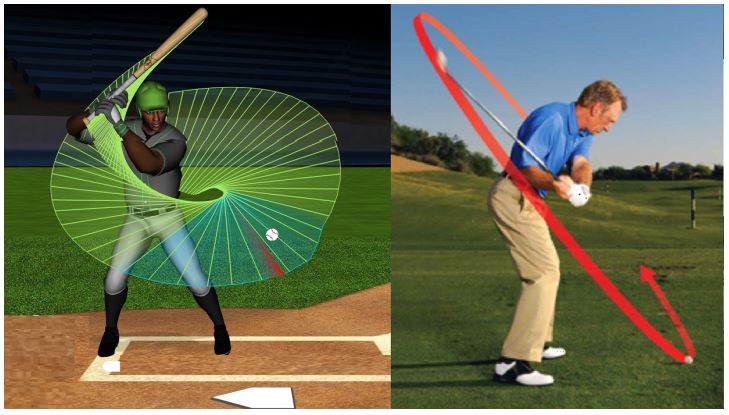
Micromanaging Metrics: A Comparative Study on Vertical Bat/Club Angle in Baseball and Golf Swings.
By Ken Cherryhomes
MLB methods, and by proxy, many coaches, micromanage through metrics interpretations, leading them to believe they can create controlled swing patterns from them, with a particular emphasis on the correlation between vertical bat angle, and batted ball launch angles. However, it’s essential to note that VBA is primarily a consequence of the batter’s natural hand-eye coordination system, which operates at a subconscious level. The perceived correlation between VBA and LA should be viewed as mostly anecdotal, as VBA is largely determined by pitch location and doesn’t directly reflect the practiced swing. This emphasis on vertical bat angle and its association with contact depth and batted ball launch angles does not fully account for the distinct characteristics of baseball swings. This paradigm, which originates from the golf sector, does not translate directly to baseball. Golf swings are predominantly linear, with the ability to adjust deviations in club angle precisely through capture metrics. But unlike golf, where these deviations can be adjusted precisely for repeatability, because of the golfer’s precise positioning relative to the ball, baseball swings rely on fluid VBA necessities, adapting to the unique conditions of each pitch location, velocity, and batter’s timing response to the pitch. These adaptations are derived through the batter’s natural hand-eye coordination system, which instinctively adjusts the VBA based on the specific conditions presented by each pitch. It is important we recognize the limitations of consciously altering VBA within a 150ms swing window and, instead, prioritize the critical aspect of timing accuracy.
The anecdotal aspect being the fact that this is ubiquitously recognized that one obviously influences the other. But because every batted ball can be reverse engineered to show the influence one had on the other, does not mean this should influence the mechanics of the swing in such a way that it is thought to be controllable in any way beyond the natural response commensurate with the conditions.
In golf, where the conditions are more controlled and the golfer can adjust their stance and positioning relative to the ball, reducing degrees of freedom can lead to greater precision. In contrast, baseball’s dynamic and unpredictable nature, including pitch location and timing, demands a higher degree of adaptability. Maintaining position and posture while allowing hand-eye coordination to adjust to different pitch heights and locations is indeed crucial in baseball, as it enables batters to effectively respond to the variety of pitches they encounter. This adaptability is a fundamental aspect of successful hitting in baseball.
The differences in the swing mechanics and adaptability required in golf and baseball make the focus on vertical club angle (VBA) observations and adjustments actionable in golf but less relevant in baseball. In golf, where the conditions are more controlled and deviations in club angle can have a significant impact on the outcome, precise adjustments are essential. However, in baseball, the fluid and dynamic nature of the game, along with the limited time to react to pitches, means that batters rely more on their natural hand-eye coordination to adapt to pitch conditions rather than precise VBA adjustments. Understanding these distinctions is crucial when developing and implementing swing analysis and training methods for each sport.
Maintaining a consistent posture to swing from in baseball is vital for allowing batters to adapt to different pitch conditions effectively. Changing posture, such as bending at the waist or tilting the pelvis dramatically, confounds the hand/eye coordination system, disrupting the batter’s initial, coordinated to the pitch, response prediction. These changes not only affect the accuracy of the swing but also shift the center of mass (COM), requiring additional compensations.
These compensations, while necessary for maintaining balance and coordination, will dissipate the available swing energy and reduce force production. Therefore, a stable and consistent posture in baseball is crucial for optimal swing performance and the batter’s ability to make real-time adjustments to pitch location, velocity, and timing. It highlights the importance of understanding the unique demands and biomechanics of baseball swings when developing training and analysis methods.
When dissecting and comparing the mechanics of baseball and golf swings, it becomes evident that these seemingly similar actions are profoundly distinct. The core divergence lies in how these sports demand different forms of control and adaptability from their athletes. Baseball swings exhibit a dynamic interplay between linear and rotational movements, driven by the unique conditions of each pitch. In baseball, batters have a distinctive approach to hitting the ball. They don’t adjust the sweet spot on the bat; it naturally follows an arc. The key is timing the swing to meet the ball intentionally based on where the sweet spot is, along this path. In contrast, in golf, it involves striking a stationary ball under controlled conditions with the possibility of repeatable precision because the ball doesn’t move. Attempts came be made, vertical club metrics examined, and a data driven change in swing can immediately be tested.
Now, let’s explore these differences more closely:
- Baseball Swing – Linear and Rotational: In a baseball swing, there is indeed a combination of linear and rotational movement. The linear component typically involves the fact that the batter’s hands begin back and finish forward of where they were launched from. However, the primary aspect of the baseball swing is rotational. The bat is continuously turning once it is launched, the sweet spot of the barrel moving from in, to out, back to in, in a semicircular manner.
- Instantaneous Alignment: Because of the rotational nature of the swing, the sweet spot of the bat aligns with any given contact point in the strike zone almost instantaneously and then moves away. This is in contrast to golf, where the relationship between the clubhead and the stationary golf ball is more linear. In golf, the golfer’s goal is to maintain a consistent clubface angle through impact to achieve desired results. This is achievable because the golfer can intentionally position the clubhead before launching their swing, leading to a more direct path to the target. In contrast, the baseball swing relies on the sweet spot arcing to the ball in a much less direct way.
- Golf Swing – More Linear and Controlled: Golf swings have a more pronounced linear aspect because the golfer’s objective is to strike a stationary ball accurately. The golf swing focuses on the precise control of the clubhead through impact to achieve the desired trajectory and accuracy. Golfers often work on maintaining a consistent swing plane and clubface angle to achieve this control. In golf, the linear aspect refers to the clubhead’s predictable and straight path toward the stationary ball on the tee. Unlike in baseball, where the bat’s sweet spot will always follow an arc from inside to outside then in line with the ball.
- VBA Control and Tangential Collisions: In baseball, the focus on controlling Vertical Bat Angle (VBA) stems from an attempt to minimize undesirable outcomes such as pop-ups. This contrasts sharply with golf, where club design and loft variability give players the ability to control vertical trajectory. In baseball, attempts to manipulate VBA to minimize vertical variances in collision outcomes are complicated by the sport’s inherent dynamics—variable pitch locations, speeds, and types. These dynamics require the batter to make real-time adaptations, limiting the utility of a fixed VBA for all scenarios. Whereas golf clubheads are designed to manage vertical trajectory specifically, the fixed design of a baseball bat coupled with the variable nature of the incoming pitch means that batters must adapt their swing organically rather than relying on a pre-calibrated VBA.
When observing the similarities between baseball and golf swings, it is equally important to examine the differences between the two. While both involve elements of linear and rotational movement, the emphasis and the dynamic nature of these movements differ significantly due to the unique demands of each sport. Baseball swings require decision adjustments based on the pitch’s location, making them more fluid and rotational in nature. Golf swings, on the other hand, prioritize precision and control, leading to a more linear and controlled motion. This understanding is crucial when developing training methods and analyzing the biomechanics of each sport.
Please send questions and comments to:
